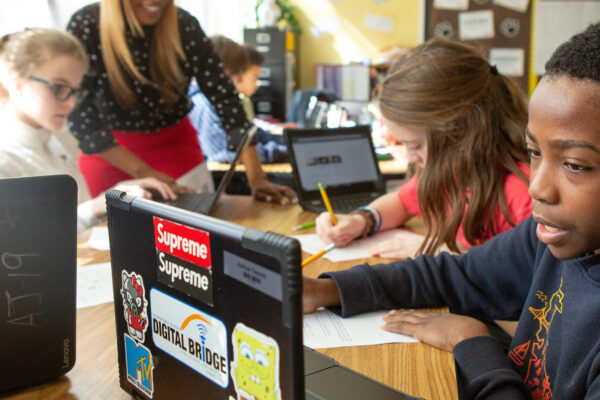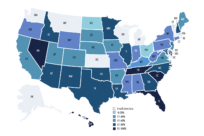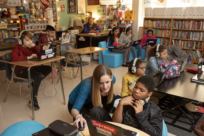Anthony Salcito is chief institution business officer at Nerdy, the parent company of Varsity Tutors. He previously spent 15 years as Microsoft’s vice president of education in the United States and vice president of worldwide education, where he led Microsoft’s work with schools and colleges.
I have been fortunate to have had a front-seat view of the evolving role of technology in the nation’s classrooms, first as Microsoft’s vice president of education in the United States and vice president of worldwide education for 15 years and more recently as an executive at Nerdy, the parent company of Varsity Tutors. That experience has given me helpful insights into how best to introduce new instructional resources in the nation’s schools—a key task as educators help students rebound from the pandemic.
The early days of classroom technology were defined by one word: acquisition. Schools sought to purchase more computers and used student-to-computer ratios to measure progress toward that goal. The technology was originally used as a supplemental resource. Then it was increasingly integrated into day-to-day classroom learning and today most educators rightfully view technology as an essential classroom tool—even as many struggled mightily to incorporate it into their lesson plans effectively early in the pandemic.

I came to call this three-step evolutionary process the “technology maturity model.” The best practices that emerged as the use of classroom technology matured can help school district leaders introduce tutoring and other resources that complement classroom instruction effectively and help learners in need.
Early technology adoption required significant buy-in from educators to adopt the systems needed to meaningfully integrate computers in classrooms. And it required a significant amount of training to help those implementing the new tools understand the connection between hardware, software and, eventually, apps and internet resources. But in many school districts there was little of either.
As a result, schools eager to have computers in the classroom during the early days of technology adoption were often sold tools that did not fully meet their needs. Without previous experience buying technology (or buying technology at scale), schools purchased hardware or software that they believed would work, only to find it fell short of expectations. Low-cost Chromebooks that provided computer access to many students but lacked functionality are a good example.
Similar challenges have emerged with tutoring. Flush with federal pandemic-response funding, district leaders are suddenly facing the unfamiliar task of vetting tutoring programs. And in their eagerness to help students recover from learning loss as quickly as possible, some have adopted tutoring programs in a rush, failing to find answers to critical questions: How effective is it? Where’s the data? Self-directed tutoring or third-party vendor? Is the program integrated with our curricula? How will we pay for the program once federal ESSER money runs out?
In some cases, schools eager to provide tutoring to as many students as possible turned to online, chat-based, on-demand tutors. While these tutors are useful in supporting a student struggling with, say, a particular math problem, they are significantly less useful when students can’t self-identify where they need help, or to support complex areas like emerging literacy.
Then think about the computer labs that schools set up in the early days of school-based edtech. Because they operated independently from the classroom and weren’t connected to the remainder of the curricula, their impact on student achievement was small—and the qualitative data nonexistent. Technology finally became an effective tool for learning once schools began integrating it into what was already going on in classrooms. Students no longer trek to the computer lab when their lessons require technology; it’s at their fingertips.
Tutoring should be just as readily accessible. And that means deeply integrating it into the daily classroom curricula and workflow. Research shows that tutoring is most effective when connected to classroom education, something that rarely happens today. For an example of what can happen when tutoring doesn’t align with the curricula, look no further than the era of supplemental educational services during the era of No Child Left Behind. Districts, required by law to offer tutoring if students did not make sufficient growth on standardized tests, paid for tutoring that wasn’t aligned with what kids were learning in their classrooms, leading to often-mediocre results.
Over time, after years on the margins of instruction, edtech tools became increasingly integrated into the classroom, with teachers able to deploy the right intervention at the right time within their classrooms. The shift to online learning in response to the pandemic, while clearly met with challenges, correctly shifted focus away from tech for tech sake to tech as a vehicle for connection, collaboration and learning. Leaders recognized their technology investment was an enabler to extend learning beyond the school and provide a robust set of tools to students. Perhaps even more important, educators had clear evidence that when the world increased reliance on technology, their role and direct impact with learners was even more valued.
If educators are able to integrate tutoring into schools’ instructional routines in the same way, tutoring could play a transformative role in schools. As always, classroom teachers, those who best understand students’ needs, are key. If teachers could quickly identify when individual students could use additional support and deploy the right modality of tutoring (which might be in-person, chat-based, or video-based) to support a student, if they could offer students personalized support via tutoring in ways that fit into daily school routines, the opportunity may exist to finally make headway on what the education psychologist Benjamin Bloom called the two sigma problem.
In the very earliest forms of education, centuries before Horace Mann introduced the Prussian, classroom-based model of education in the United States, learning was often a sharing of information between a tutor or philosopher and a student or small group of students. The model was highly effective, but also expensive and therefore largely limited to the privileged. Yet while Mann’s work expanded formal education to many more students, the one-to-many classroom model of instruction didn’t deliver the same depth of learning as a one-to-one experience.
According to Bloom, who created the famous heirarchy of learning objectives known as Bloom’s Taxonomy, outcomes for students who received one-to-one tutoring surpassed those of classroom instruction by two standard deviations, or two sigma. He proffered that if schools could make tutoring standard practice—if they could find a way to deliver it at scale—“it would be an educational contribution of the greatest magnitude” that could change “popular notions about human potential.”
Today, nearly 40 years later, if teachers could deploy tutoring as easily as many now deploy computers—reinforcing a particularly complicated lesson that a student didn’t fully grasp, say, or assigning small-group tutoring to four students who made Cs on a recent test—schools may be closer to making Bloom’s vision a reality.




